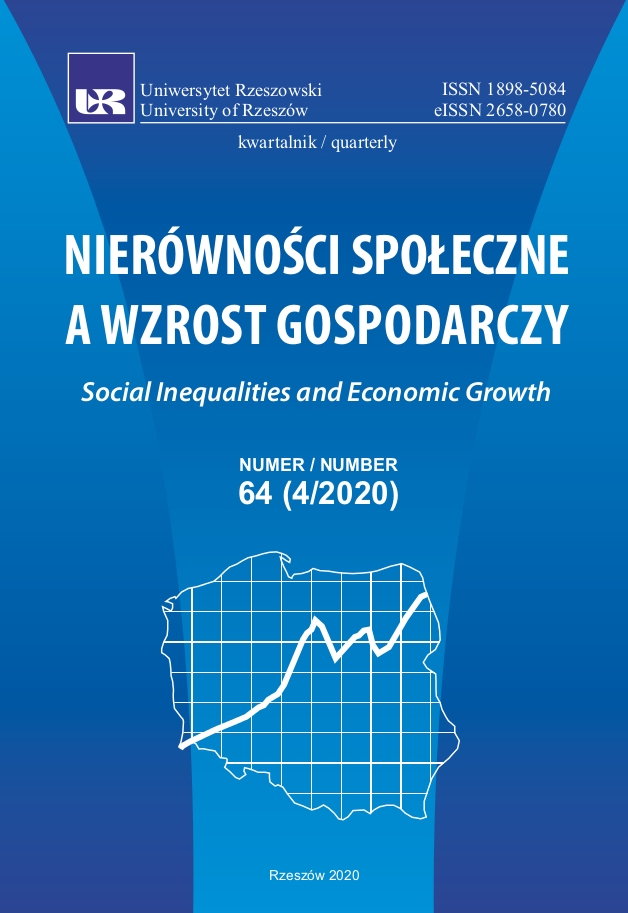Udział funduszy Unii Europejskiej w rozwoju obszarów wiejskich na przykładzie gminy Brześć Kujawski
DOI:
https://doi.org/10.15584/nsawg.2020.4.16Słowa kluczowe:
obszary wiejskie, Unia Europejska, rozwój gminy, fundusze europejskieAbstrakt
W opracowaniu przeprowadzono ocenę inwestycji i projektów zrealizowanych w gminie Brześć Kujawski przy wsparciu środków finansowych UE po integracji Polski z UE w 2004 roku. W maju i czerwcu 2019 roku zostały wykonane badania sondażowe techniką ankiety wśród 100 mieszkańców gminy, głównie zamieszkałych na terenach wiejskich. W badaniach przeanalizowano także dokumentację zawierającą opisy inwestycji realizowanych przez Urzędy Miasta i Gminy Brześć Kujawski po wstąpieniu Polski do UE. W czerwcu 2019 roku wykonano wywiad z władzami gminy i osobami odpowiedzialnymi za pozyskiwanie środków unijnych. W efekcie analizy zebranego materiału stwierdzono, że środki unijne miały duży udział w finansowaniu projektów prowadzonych na terenie gminy (64,3%). Badani mieszkańcy w większości zauważali zmiany, jakie nastąpiły przez 15 lat w gminie Brześć Kujawski dzięki wykorzystaniu środków finansowych z programów UE. W badaniach twierdzono, że koszty eksploatacyjne ukończonych inwestycji nie obciążają nadmiernie budżetu gminy. Badani w większości pozytywne oceniali zmiany wynikające z rozwoju gminy, dzięki dofinansowaniu ze środków UE. Najbardziej pozytywne opinie wyrażały osoby: lepiej wykształcone, w młodszym wieku, mieszkające od urodzenia w badanej gminie, uczniowie i studenci oraz rolnicy, a także częściej były to kobiety niż mężczyźni. Z badań wynika, że większość respondentów (65,0%) nie korzystała nigdy z dofinansowania ze środków Unii Europejskiej. W opinii badanych osób wstąpienie Polski do Unii Europejskiej jest korzystne dla kraju i mieszkańców oraz osobiście dla respondentów. Większość badanych wyrażała również zadowolenie z członkostwa Polski w UE (60%).
Downloads
Bibliografia
Antczak, A., Kopeć, A. (2017). Szanse i zagrożenia w rozwoju polskich obszarów wiejskich w ramach PROW 2014–2020. Organizacja i Zarządzanie, 1217(68), 17–27.
Cupiał, M., Rorat, J., Szeląg-Sikora, A. (2018). Kierunki rozwoju społeczno-gospodarczego obszarów wiejskich w świetle Programu Rozwoju Obszarów Wiejskich na lata 2014–2020. Studia i Prace WNEiZ US, 51, 47–59.
Czudec, A., Kata, R., Wosiek, M. (2019). Reducing the development gaps between regions in Poland with the use of European Union funds. Technological and Economic Development of Economy, 25(3), 447–471. DOI: 10.3846/tede.2019.9483.
Heller, J., Szczepaniak, A. J. (2008). Regionalne uwarunkowania i efekty podziału funduszy z Unii Europejskiej. Studia Regionalne i Lokalne, 2(32), 112–123.
Kalinowski, S. (2018). Problem ubóstwa i wykluczenia społecznego w krajach Unii Europejskiej w kontekście zrównoważonego rozwoju. Wieś i Rolnictwo, 3(180), 93–112. DOI: 10.7366/wir032018/04.
Kata, R., Miś, T. (2006). Regional disparities of Poland’s agriculture in aspect of its financing from the European Union funds. New Members – New Challenges for the European Regional Development Policy. Novy Smokoves: Technical University of Košice, University of Economics in Bratislava, German Section in ERSA, 164–170.
Kozera-Kowalska, M., Uglis, J. (2020). Spatial diversity of the attractiveness of rural communes for enterprise development in Poland. Annals PAAAE, XXII(2), 88–98. DOI: 10.5604/01.3001.0014.1552.
Radomski, P., Moskała, P., Mikosz, P. M. (2016). Transfer wiedzy i innowacji w PROW 2014–2020. Wiadomości Zootechniczne, 54(4), 168–172.
Roman, M. (2018). Innowacyjność agroturystyki jako czynnik poprawy konkurencyjności turystycznej makroregionu Polski Wschodniej. Warszawa: Wydawnictwo SGGW.
Satoła, Ł. (2016). Wykorzystanie funduszy Unii Europejskiej na inwestycje komunalne a ograniczanie zadłużenia samorządów. Zeszyty Naukowe SGGW, seria Polityki Europejskie, Finanse i Marketing, 15(64), 139–148.
Satoła, Ł., Bogusz, M. (2016). Supporting the development of entrepreneurship in rural areas from structural funds of the European Union (using the example of Małopolskie Province). Intercathedra, 32(1), 66–74.
Satoła, Ł. (2017). Społeczna percepcja inwestycji komunalnych współfinansowanych z funduszy strukturalnych. Nierówności Społeczne a Wzrost Gospodarczy, 49(1/2017), 291–301. DOI: 10.15584/nsawg.2017.1.22.
Śmiglak-Krajewska, M. (2019). Innovativeness of young farmers based on farms in the Wielkopolskie province. W: P. Jedlicka, I. Soukal, P. Maresova (red.), Hradec Economic Days: Double-blind peer reviewed proceedings of the International Scientific Conference Hradec Economic Days 2019 (s. 321–322). Hradec Kralove: University of Hradec Kralove.
Uglis, J., Kozera-Kowalska, M. (2019). Synthetic measure of rural area attractiveness for living, working and business activities – concept analysis and statistical evaluation. Annals PAAAE, XXI(2), 275–284. DOI: 10.5604/01.3001.0013.2087.
Uglis, J., Tratwal-Uglis, N. (2011). Odnowa i rozwój wsi w województwie wielkopolskim – studium przypadku gminy Granowo. Prace Naukowe Uniwersytetu Ekonomicznego we Wrocławiu, 17, 283–292.
Woś, B. (2005). Rozwój regionów i polityka regionalna w Unii Europejskiej oraz w Polsce. Wrocław: Oficyna Wydawnicza Politechniki Wrocławskiej.
Wyszkowska, Z., Michalska, A., Koreleska, E. (2019). Współczesne trendy na rynku pracy. Aspekty makroekonomiczne. Bydgoszcz: Wydawnictwo Uczelniane UTP w Bydgoszczy.
Pobrania
Opublikowane
Jak cytować
Numer
Dział
Licencja
Prawa autorskie (c) 2020 Uniwersytet Rzeszowski

Utwór dostępny jest na licencji Creative Commons Uznanie autorstwa – Na tych samych warunkach 4.0 Miedzynarodowe.


